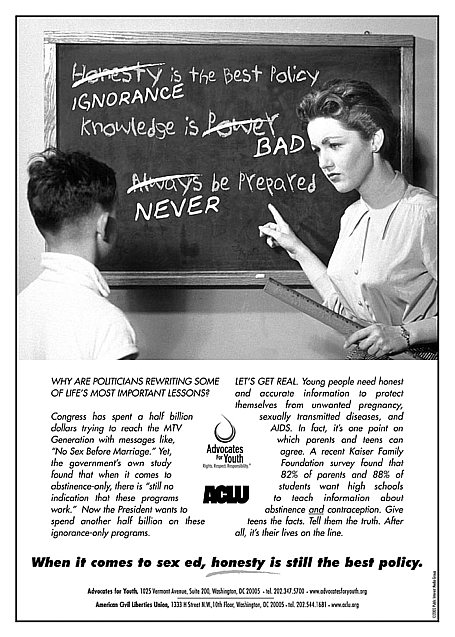

mailto: payer@payer.de
Zitierweise / cite as:
Payer, Margarete <1942 - >: Informationsmarktverzerrung durch Fundamentalismus am Beispiel der USA. -- Kapitel 3: Sexuelle Aufklärung und AIDS. -- 4. Der Staat und Abstinence only. -- Fassung vom 2005-05-27. -- URL: http://www.payer.de/fundamentalismus/fundamentalismus04.htm
Erstmals publiziert: 2005-03-23
Überarbeitungen: 2005-05-27 [Ergänzungen]
Anlass: Lehrveranstaltung an der Hochschule der Medien Stuttgart, Sommersemester 2005
Copyright: Dieser Text steht der Allgemeinheit zur Verfügung. Eine Verwertung in Publikationen, die über übliche Zitate hinausgeht, bedarf der ausdrücklichen Genehmigung des Verfassers.

Diese Inhalt ist unter einer Creative Commons-Lizenz lizenziert.
Dieser Text ist Teil der Abteilung Länder und Kulturen von Tüpfli's Global Village Library

Abb.: Plakat der ACLU (American Civil Liberties Union)
Nebenbei bemerkt:
Abb.: War nicht für Abstinence only und musste deshalb gehen: Carol Bellamy [Bild: UNICEF]"Bei den Vereinten Nationen werden einige wichtige Spitzenämter neu besetzt, und Beobachter fragen sich, inwieweit UN-Generalsekretär Kofi Annan mit seinen Personalentscheidungen Forderungen der US-Politik Folge leistet. So ernannte Annan Mitte Januar die bisherige Landwirtschaftsministerin in der Regierung von Präsident George W. Bush, Ann Veneman. zur neuen Leiterin des UN-Kinderhilfswerks UNICEF. Laut Medienberichten war die Bush-Regierung mit der bisherigen UNICEF-Leiterin, der US-Amerikanerin Carol Bellamy, wegen ihrer liberalen Ansichten zu Sexualaufklärung und Verhütung zunehmend unzufrieden. Veneman erklärte denn auch noch vor ihrer Ernennung, ihrer Ansicht nach seien diese Themen nicht wichtig für die Arbeit von UNICEF; unter ihrer Leitung würden die Reibereien mit Washington ein Ende haben. Kofi Annan sagte bei der Vorstellung Venemans, natürlich seien für die Arbeit der neuen UNICEF-Leiterin „Beziehungen und Kontakte in Washington hilfreich, so wie wir früher die Kontakte und Beziehungen anderer genutzt haben"."
[Quelle: E + Z Entwicklung und Zusammenarbeit. -- 46. Jg. (2005). -- Nr. 3. -- S.128]
Brief History of Abstinence-Only-Until-Marriage Education Abstinence-only-until-marriage education has been taught for over two decades and yet there is still no peer-reviewed research that proves it is effective. Government funding of abstinence-only-until-marriage programs is not new. In fact, the federal government has poured large sums of money into such programs for the past 20 years.
AFLA: the birthplace of abstinence-only programs.
The U.S. Office of Population Affairs began administering the Adolescent Family Life Act (AFLA) in 1981. This program was designed to prevent teen pregnancy by promoting chastity and self-discipline.During its first year, AFLA received $11 million in federal funds. In fiscal year 2000, AFLA received $19 million.
AFLA’s early programs taught abstinence as the only option for teens and often promoted specific religious values. As a result, the American Civil Liberties Union filed suit in 1983 charging that AFLA violated the separation of church and state as defined in the U.S. Constitution. In 1985, a U.S. district judge found AFLA unconstitutional. On appeal in 1988, the U.S. Supreme Court reversed that decision and remanded the case to a lower court.
Finally, an out-of-court settlement in 1993 stipulated that AFLA-funded sexuality education programs must: (1) not include religious references, (2) be medically accurate, (3) respect the “principle of self-determination” regarding contraceptive referral for teenagers, and (4) not allow grantees to use church sanctuaries for their programs or to give presentations in parochial schools during school hours. Within these limitations, AFLA continues to fund abstinence-only programs today.
Abstinence-only-until-marriage education as defined in AFLA has been taught for over two decades and yet there is still no peer-reviewed research that proves it is effective in changing adolescents’ behavior. To the contrary, a meta-evaluation of AFLA program evaluations found them “barely adequate” to “completely inadequate.”
Congress institutes similar programs through Doolittle amendment.
The first Congressional attempt to censor sexuality education using an abstinence-only provision came in 1994 during the reauthorization of the Elementary and Secondary Education Act. Representative John Doolittle (R-CA) introduced an amendment to limit the content of HIV-prevention and sexuality education in school-based programs.
Fortunately, four federal statutes required alterations to the Doolittle amendment. The Department of Education Organization Act (Section 103a), the Elementary and Secondary Education Act (Section 14512), Goals 2000 (Section 319 (b), and the General Education Provisions Act (Section 438) all prohibited the federal government from prescribing state and local school curriculum standards.
Proponents of abstinence-only programs learned from this that even though they could not legally restrict state and local education programs that they could restrict and define the scope of state and local health policy and funding. They applied their new-found lesson in 1996.
Federal entitlement program promotes abstinence-only-until-marriage.
That year, the federal government attached a provision to the popular welfare-reform law establishing a federal entitlement program for abstinence-only-until-marriage education.
This entitlement program, Section 510(b) of Title V of the Social Security Act, funneled $50 million per year for five years into the states. Those states that choose to accept Section 510(b) funds are required to match every four federal dollars with three state-raised dollars and then disperse the funds for educational activities.
Programs that use the funds are required to adhere to a strict eight-point definition, which, among other things, requires them to teach that “sexual activity outside of marriage is likely to have harmful psychological and physical effects.” (The complete definition is on page 11.) The section 510(b) abstinence-only-until-marriage funds are up for reauthorization in 2001.
Other federal abstinence legislation.
Since inception, over a half billion tax dollars have been spent on abstinence-only-until-marriage programs. In November 1999, opponents of comprehensive sexuality education, family planning, and reproductive rights began a process that successfully secured an additional 50 million federal dollars for abstinence-only-until-marriage programs over the next two years. Although these funds are not part of Section 510(b), they are only available for programs that conform to the strict eight-point definition in 510(b).
These new funds will be awarded directly to state and local organizations by the Maternal and Child Health Bureau through a competitive grant process instead of through state block grants as is the case for 510(b) funds. Many viewed this decision as an attempt by conservative lawmakers to control the funding and prevent money from supporting media campaigns, youth development, and after-school programs that they saw as diluting the abstinence message.
[Quelle: http://www.nonewmoney.org/history.htm. -- Zugriff am 2005-03-09]

Abb.: Stolze SPRANS-Empfänger
[Bildquelle:
http://ci.chillicothe.oh.us/photos/SPRANS16.JPG. -- Zugriff am 2005-05-27]
"Special Projects of Regional and National Significance (SPRANS) History: In the fall of 1999, Congress allocated $20 million in advance funding for FY 2001 and $30 million in advance funding for FY 2002 for abstinence-only-until-marriage programs through the Maternal and Child Health Block Grant's SPRANS program (Special Projects of Regional and National Significance). This program allows community-based organizations that follow a strict adherence to the 8-point restrictive definition of "abstinence education" as defined under Section 510 of the Social Security Act to apply for grant money directly to the Department of Health and Human Services. Unlike under welfare reform, grantees of the SPRANS program have stricter guidelines and MUST adhere to all eight points of the welfare reform definition of abstinence.
On July 6, 2001, the Department of Health and Human Services distributed $17.1 million to 49 communities to implement abstinence-only-until-marriage programs for young people from ages 12-18. HHS later distributed another four grants totaling $758,070 to organizations in California, Texas, Wisconsin and Minnesota. Two of the grants were three-year implementation grants and two were one-year planning grants.
Fiscal Year 2002 Funding: Congress allocated $40 million for the SPRANS abstinence-only-until-marriage program for FY 2002. In his budget proposal for FY 2003, President Bush requested $73 million for SPRANS, an unprecedented 83 percent increase over the last fiscal year. Under the Labor, Health and Human Services, and Education Appropriations bill, the Senate Appropriations Committee rejected the President's request and voted to level-fund the SPRANS abstinence-only program for FY 2003. The House of Representatives has not acted on the LHHS Appropriations bill.
Like Welfare Reform, the funding for SPRANS is also tied to an extremely narrow, morality-based definition of abstinence-only education that puts teens at risk. The eight-point definition first formulated under the 1996 welfare law condemns all sexual activity outside of marriage, for people of any age.
Under welfare reform grantees do not have to comply with all eight points, but cannot be out of compliance with any of the points. However, under the SPRANS grants, programs that receive funding must adhere to all eight points of the abstinence-only definition.
Under the law, an "abstinence education" program means an educational program which:
- Has as its exclusive purpose, teaching the social, physiological, and health gains to be realized by abstaining from sexual activity;
- Teaches abstinence from sexual activity outside of marriage as the expected standard for all school age children;
- Teaches that abstinence from sexual activity is the only certain way to avoid out-of-wedlock pregnancy, sexually transmitted diseases and other associated health problems;
- Teaches that a mutually faithful monogamous relationship in the context of marriage is the expected standard of human sexual activity;
- Teaches that sexual activity outside of the context of marriage is likely to have harmful psychological and physical effects;
- Teaches that bearing children out-of-wedlock is likely to have harmful consequences for the child, the child's parents, and society;
- Teaches young people how to reject sexual advances and how alcohol and drug use increases vulnerability to sexual advances; and
- Teaches the importance of attaining self-sufficiency before engaging in sexual activity."
[Quelle: http://www.advocatesforyouth.org/sprans.htm. -- Zugriff am 2005-05-27]
Das Alan Guttmacher Institute schreibt in der Untersuchung Sex and STD/HIV Education, Stand 1. Mai 2004:
BACKGROUND: The advent of the AIDS epidemic in the 1980s spurred states to reevaluate their sex education policies and, in some cases, expand their requirements. Most states require that public schools teach some form of sex or STD/HIV education. Most states, including some that do not mandate the instruction itself, also place requirements on how abstinence or contraception should be handled when included in a school district's curriculum. This guidance is heavily weighted toward stressing abstinence; in contrast, while many states allow or require that contraception be covered, none requires that it be stressed. Further affecting whether students receive instruction on sex or STDs/HIV are parental consent requirements or the more frequent "opt-out" clauses, which allow parents to remove students from
instruction the parents find objectionable.HIGHLIGHTS:
- 22 states and the District of Columbia mandate that public schools teach sex education; many states, including several that do not mandate sex education, place requirements on how abstinence and contraception are treated when taught.
- 21 states require that abstinence be stressed when taught as part of sex education; 9 states require simply that it be covered during instruction.
- 14 states and the District of Columbia require that sex education programs cover contraception; no state requires that it be stressed.
- 38 states and the District of Columbia require the provision of STD/HIV education; many place requirements on how abstinence and contraception are treated.
- 25 states require that abstinence be stressed when taught as part of STD/HIV education; 9 require that it be covered.
- 17 states require that STD/HIV programs cover contraception; no state requires that it be stressed.
- 38 states and the District of Columbia require school districts to permit parental involvement in sexuality and STD/HIV education.
- 3 states require parental consent in order for students to participate in sex or STD/HIV education.
- 35 states and the District of Columbia allow parents remove their children from instruction.
[Quelle: http://www.siecus.org/policy/states/AGI_Chart.pdf. -- Zugriff am 2005-03-09]
Dieselbe Studie gibt folgende Übersicht über die einzelnen Staaten:
| State Sex and STD/HIV Education Policy | ||||||||
| STATE | SEX EDUCATION | STD/HIV EDUCATION | PARENTAL ROLE | |||||
| MANDATED |
If taught, content required |
MANDATED |
If taught, content required |
Consent Required | Opt-out Permitted | |||
| Abstinence | Contraception | Abstinence | Contraception | ALABAMA | STRESS | COVER | X | STRESS | COVER | X* |
| ALASKA | X | X | ||||||
| ARIZONA | STRESS | STRESS | X* | X* | ||||
| ARKANSAS | STRESS | STRESS | ||||||
| CALIFORNIA | COVER | COVER | X | STRESS | COVER | X | ||
| COLORADO | ||||||||
| CONNECTICUT | COVER | X | X | |||||
| DELAWARE | X | COVER | COVER | X | COVER | COVER | ||
| DIST OF COLUMBIA | X | COVER | X | X | ||||
| FLORIDA | X | COVER | X | X | ||||
| GEORGIA | X | COVER | X | COVER | X | |||
| HAWAII | X | STRESS | COVER | X | STRESS | COVER | ||
| IDAHO | X | |||||||
| ILLINOIS | X | STRESSa | COVERa | X | COVER | X | ||
| INDIANA | STRESS | X | STRESS | |||||
| IOWA | X | X | X | |||||
| KANSAS | X | X | X | |||||
| KENTUCKY | X | COVER | X | COVER | ||||
| LOUISIANA | STRESS | STRESS | X | |||||
| MAINE | X | STRESS | COVER | X | STRESS | COVER | X | |
| MARYLAND | X | STRESS | COVER | X | STRESS | COVER | X | |
| MASSACHUSETTS | X* | |||||||
| MICHIGAN | COVER | X | COVER | X | ||||
| MINNESOTA | X | X | COVER | X | ||||
| MISSISSIPPI b | STRESS | STRESS | X | |||||
| MISSOURI | STRESS | COVER | X | STRESS | COVER | X | ||
| MONTANA | x+ | |||||||
| NEBRASKA | ||||||||
| NEVADA | X | X | X | |||||
| NEW HAMPSHIRE | X | |||||||
| NEW JERSEY | X | STRESS | X | STRESS | X* | |||
| NEW MEXICO | X | STRESS | COVER | |||||
| NEW YORK | X | STRESS | COVER | x+ | ||||
| NORTH CAROLINA | X | STRESS | X | STRESS | X | |||
| NORTH DAKOTA | X | |||||||
| OHIO | X | STRESS | X | |||||
| OKLAHOMA | STRESS | X | COVER | COVER | X | |||
| OREGON | STRESS | COVER | X | STRESS | COVER |
X |
||
| PENNSYLVANIA | X | STRESS | X*+ | |||||
| RHODE ISLAND | X | STRESS | COVER | X | STRESS | COVER | X | |
| SOUTH CAROLINA | X | STRESS | COVER | X | STRESS | COVER |
|
X |
| SOUTH DAKOTAc | ||||||||
| TENNESSEE | X | STRESS | X | STRESS | X | |||
| TEXAS | STRESS | STRESS | X | |||||
| UTAH d | X | STRESS |
|
X | STRESS | X | ||
| VERMONT | X | COVER | COVER | X | COVER | COVER | X* | |
| VIRGINIA | COVER | COVER | COVER | COVER | X | |||
| WASHINGTON | X | STRESS | COVER | X | ||||
| WEST VIRGINIA | X | STRESS | COVER | X | STRESS | COVER | X | |
| WISCONSIN | X | X | ||||||
| WYOMING | X | X |
|
|||||
| TOTAL IN EFFECT | 22 +DC | 21 Stress 9 Cover | 14 + DC Cover | 38+DC | 25 Stress 9 Cover | 17 Cover | 3 | < 35 +DC |
STRESS = Betonung auf
COVER = wird behandelt
* Parents' removal of student must be based on religious or moral beliefs.
+ In AZ, MT, NY and PA, opt-out is only permitted for STD education, including instruction on HIV/AIDS; in AZ, parental consent is required only for sex education.
a IL has a broad law mandating comprehensive health education, including abstinence instruction; a more specific second law requires a school district that elects to provide the specific sex education package to stress abstinence and cover contraception.
b Localities may override state requirements for sex education topics, including abstinence; state prohibits including material that "contradicts the required components."
c Abstinence is taught within state-mandated character education.
d State prohibits teachers from responding to students' spontaneous questions in ways that conflict with the law's requirements.
[Quelle: http://www.siecus.org/policy/states/AGI_Chart.pdf. -- Zugriff am 2005-03-09]
Zu Kapitel 3.5.: Informationsmanager gegen Prüderie